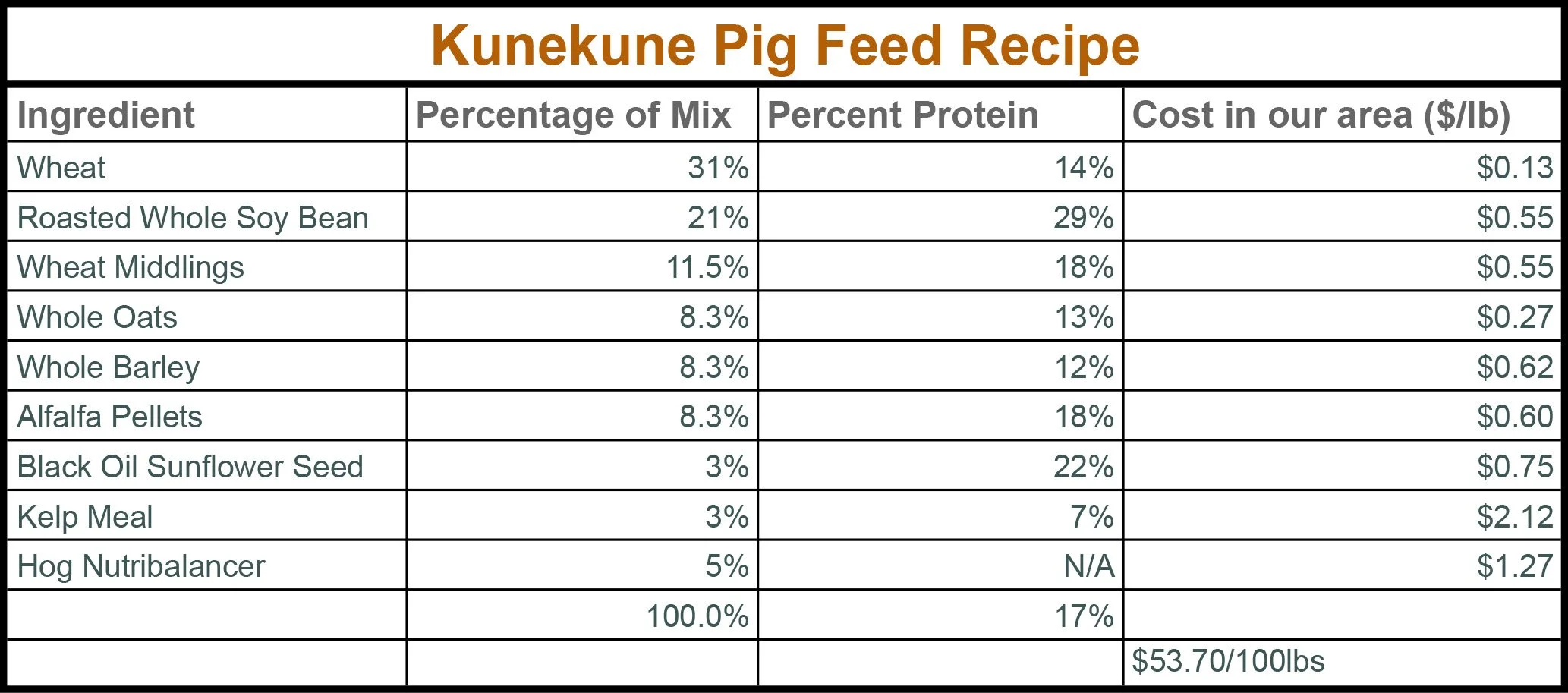KuneKune Pig Feed Recipe
Boris, Bacon, and Ham, patiently waiting for their morning snack.
Kunekune pigs are quite unique in the porcine world. Truly a pasture pig, they can get by on little else but natural forage. Now, let’s not fool ourselves. Pigs, regardless of breed, are omnivores by design. Commercial hogs can be fed any number of food scraps, animal parts, and whatever slop a producer wants to offer up. Over the years that has given pork a bad rap as the garbage disposals of commercial meat production and thus, pork as been bedeviled by the unsavory characters who’ve raised in to maximize profit and minimize effort. But a ray of sunshine splits that cloud of despair, as small producers are popping up all over the place to break the mold, raising and selling pork of the utmost quality and ethical considerations.
The kunekune pig, nearly extinct by the 1980’s has come back with a vengeance as some of the highest quality pork money can buy. Naturally, we bought ourselves a breeding pair and a pair for our own consumption aptly named “Bacon” and “Ham”. In a natural environment in their native New Zealand countryside, these pigs would have foraged for whatever tickled their fancy. In the homesteading and small farm boom of the last decade, especially in the western world, these pigs are now climbing to the pinacle of pasture-raised pork. A lard pig, of fairly small stature, only maturing to around 250 pounds in adulthood, these pigs naturally forage shrubs, forbes, grasses, nuts, and grubs. But to do it up right, removed from their native lands and now confined in an American farm setting without the ability to roam freely across the landscape, these pigs need a bit of a nutrient boost from grain and supplemental feed to remain healthy and vibrant.
Today, large scale producers line New Country Organics have put a lot of work into understanding the dietary needs of pigs, especially those raised in a pastured setting. Considering things like corn and/or soy free, organic feed for the health of the pig and the health of the individual consuming that finished pork product has given them a tremendous name in these health-conscious circles. More power to them! I love their business and what it stands for. I must admit, however, that my pocket book and lack of traditional farm equipment like a tractor and loader all but cut me out of the chain as potential customer of theirs. So I mirrored their recipe with my own subtle twists in order to source the same quality feed through our local mill. Based on the ingredient list on the back of their label and with a target of 17-18% protein for the pigs, the recipe in this article is what we feed our pigs daily, and we love the results.
Rosie, our gilt and soon-to-be first-time momma, enjoying her snack of grain
Please note, that we are a very health-conscious family. Processed foods, unnecessary food dies, so-called “natural” ingredients, and the like do not often find their way into our digestive tracts. At the same time, we live in this world and far from perfect as it is, we know that we simply cannot cut out all the bad stuff completely. Our approach is one of diligence and moderation. We keep close tabs on how we, children included, behave and feel when we eat different foods and adjust accordingly. In light of that, we also agree with the Lunatic Farmer in his notion regarding soy-based products. While acknowledging that there are many studies that find soy to be impactful in the increased level of estrogens circulating in our society today, he also noticed the nuance. The studies done on soy have largely been done on the ultra-processed versions of those things, namely soy meal (where the oil has been pressed out of the bean) and soy oil (where the meal has been removed), rather than on whole roasted soy bean.
This tracks with the apparent dangers of things like seed oils. olives have a natural oil. Coconut has natural oil. Avacodo has natural oil. These items all have a high fat content which facilitates the extraction of oil from the product. Soy bean, cotton seed, flack seed, sunflower, etc., likely have no business having their oils, what little there are, extracted and used for cooking. Furthermore, in Joel Salatin’s 2018 adendem to his book “Pastured Poultry Profits” he highlights a much more recent study in chickens that found that excess clover in the diet actually led to higher instances of estrogen in the musculature of the chicken when compared to any other feed ingredient, including the defamed soy bean. All this to say, we track with his logic. A local food economy, even with the pitfall of potential ingredients, is far superior to a global food economy. Therefore, while we could use a likely substitute, field peas, as the dominant protein source in our pigs feed, we choose not to. Those peas would have to be imported from hundreds of miles away, raising our cost and ultimately raising the cost of the finished pork goods at the level of consumer. We source local, non-GMO, soy beans, roasted locally, and then ground in our own personal grain mill, keeping the bean in tact, the sum of its parts, to preserve the “beanness” of the soy bean. Our feed is non-GMO, sourced locally, mixed locally, ground locally, and is much better for it.
And so, without further adieu, our pig feed mix is below. Feel free to try it for yourself and play around with it!



